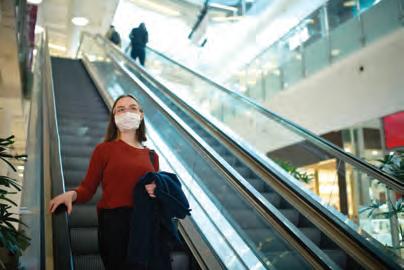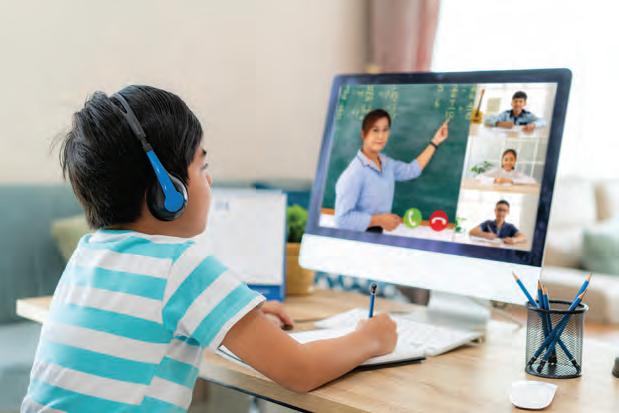
4 minute read
Permanent Modifications
PERMANENT
MODIFICATIONS
If you’re waiting for the pandemic to end so that life will get back to “normal,” don’t hold your breath. Makeshift practices that accompany a crisis often become standard operating procedure when it’s over. Consider lockdown drills instituted after Columbine, and removing your shoes in airport security lines since 9/11. Here, experts pinpoint some of COVID’s lingering after effects.
Shopping malls have been slowly dying.
But the trend accelerated during COVID when footfall dropped to 49 percent, says foot-trafficanalytics firm Placer.ai. As a result, even normally well-performing malls are retooling leases and recruiting a new mix of tenants, including non-retail businesses.

“The COVID-19 pandemic has accelerated 10 key technology trends, including digital payments, telehealth and robotics,” proclaims the World Economic Forum. “They are playing a crucial role in keeping our society functional in a time of lockdowns and quarantines, and may have a long-lasting impact beyond COVID 19.”

Buying versus shopping
The concept that physical retail is about shopping, not buying will continue to expand, said Mitch Joel, a speaker at the National Retail Federation’s 2021 virtual show. As brick-and-mortar retailers figure out how to make the in-store experience more of a buying experience, online retailers are learning how to create more of a shopping experience using video and chat. “The retailers who succeed will successfully blend shopping and buying experiences,” he said.
Building the necessary infrastructure
to support a digitized world and stay current in the latest technology will be essential for any business or country to remain competitive in a post-COVID-19 world, says the World Economic Forum.

I don’t think we should shake hands ever again, to be honest with you,
said Dr. Anthony Fauci in April. Popular alternatives to the handshake include a head nod, foot tap, peace sign, and the namaste greeting – hands over the heart in prayer pose and a little had bow. No touching.
There is no getting back to normal.
Thomas Davenport told CNN. “The sooner we accept that, the better.” The President’s Distinguished Professor of Information Technology and Management at Babson College says that people who don’t – including some who refuse to wear masks – have a condition called normalcy bias. “They want life to go back to the way it was rather than figuring out how to deal with what’s ahead.”
For brick-andmortar stores,
health, well-being, and safety are now table stakes, says Colin
Stewart, executive vice president of business intelligence at
Acosta. “Social distancing, touch-free and transparency will continue to drive the way we live our lives and the way we shop.”
Michael Lubelfeld, superintendant of North Shore School District 112 in Highland Park, Illinois, predicts that creativity postpandemic will encompass school fiscal planning.
he asked Education Dive. “What if we can still provide robust and rigorous public schooling at the highest level of quality for all children, yet we don’t need to put all that public funding into brick and mortar if we don’t really need it full-time for everyone all the time?”
No More Snow Days
“Time and place are irrelevant now that we can move outside the classroom to wherever we need to be to push out instruction,” Director of Schools Donna L. Wright told Education Dive. Her district, Wilson County Schools in Tennessee, historically stockpiles 13 days for inclement weather or illness. “Now we have the opportunity to provide instruction in the comfort of one’s home.”

Learning model experimentation and innovation will continue to
increase. “Over the years, we have always found that when teachers have space to try something new, they become the best source of information on how to improve the innovation on behalf of students,” said an article on the website RedefinED.
COVID’s “Missing Students”
may never return to school. Education news site The 74 compares student displacement from the pandemic to the aftermath of Katrina. Outreach to absent or struggling students will help, but only if schools can find them. “Louisiana and Texas have systems for tracking enrollments and closures due to hurricanes in a way that a state like Maryland just doesn’t,” said one expert.

The switch to tech-supported learning is permanent,
wrote Julie Young, VP of education outreach and student services for Arizona State University and CEO of ASU Prep Digital High School. “No digital learning professional would have wished 2020 on any teacher – it was more about patching holes and saving the ship. But since many of the tools teachers are using are free or low-cost, the uptick in using digitally supported learning tools is here to stay, even in brick-and-mortar schools.”
Educators hope that the
strong connections forged between parents and school staff
during the pandemic will remain. Back-and-forth communications increased and appreciation grew for each other’s challenges and successes, reports Education Dive.
Given the number of creative “school” options that have emerged
(microschools, homeschool, unschool, learning pods),
some parents will abandon traditional public options altogether. Business travel and working in the office will not return to pre-pandemic levels, predicts Bill Gates. At Microsoft, for instance, employees report to the office for just half the workweek with one downside:
missing the chance to meet
new people. “More could be done on the software side of virtual meetings to allow for serendipitous run-ins afterwards,” noted Gates.










